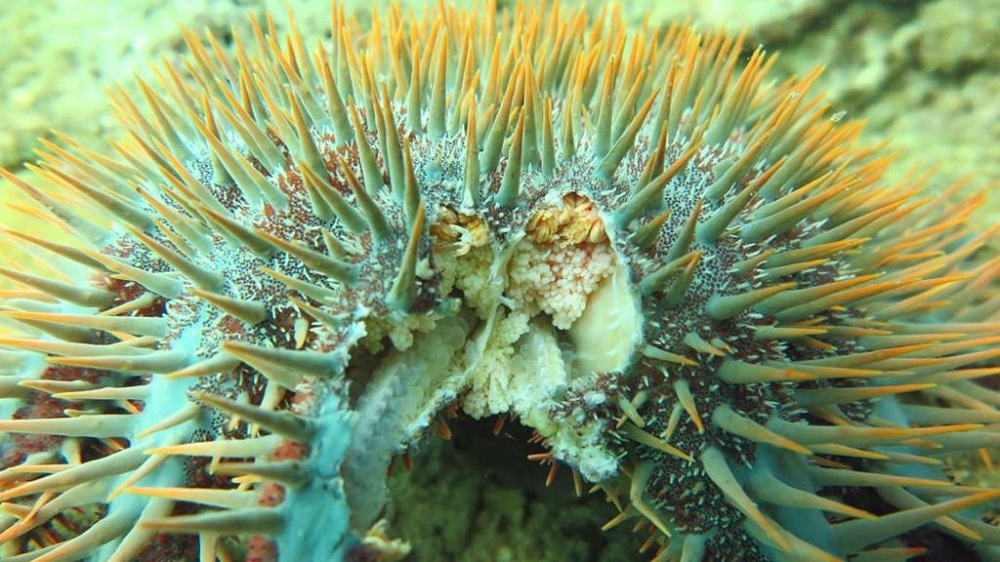
Subscribe to our Telegram channel for the latest updates on news you need to know.
KOTA KINABALU, April 17 — While the city and parts of the state are fending off more Covid-19 infections, the Tunku Abdul Rahman Marine Park here is facing an underwater outbreak of its own.
The dreaded crown-of-thorns starfish (CoT), a known aggressive coral predator, has been invading the park. The local dive community fear the park is in danger of losing its coral reefs and eventually, its diving industry.
“Large areas of our popular reefs are being destroyed right now. In three days, we have terminated some 150 or so of them, but there are many more, and we cannot possibly get rid of them all on our own,” said volunteer marine conservation group Dive Rangers’ founder Bob Hartley.
Hartley, who is among those co-ordinating efforts to get rid of the CoTs, said groups of divers were deployed to remove the thorny starfish, together with divers from Sabah Parks — the marine park authorities — in the last week since the problem was identified almost two weeks ago.
“We funded, through public donations, six divers to remove 100 CoTs last week. Sabah Parks has also been using their divers — 10 to 15 people in total. Dive Rangers has 27 volunteer divers willing to support Sabah Parks, but it will need more than that,” said Hartley.
Marine biologist Firdaus Akmal, who has been working at a resort in the park, said that the danger of the predator starfish was that it could ingest 10 metre square of corals per year and an outbreak could see the collapse of a healthy coral reef in a short time, leading to the devastation of the marine park.
“It is considered an outbreak when the density of the CoTs reaches 30 per hectare, and what we are seeing now is more than that,” said Firdaus.
He said officially, operations have destroyed some 192 CoTs from two adjacent dive spots — Clement Reef and South Sapi — last week, with another 34 later. Other dive operators also pick up and destroy the CoTs when they come across them as well.

While some remove the starfish from the water and bury it in sand, the group has taken to injecting vinegar into the CoTs which kills it and allows it to be eaten by other fish almost immediately.
“Such an outbreak has happened before. The most recent (incident) prior to this one was in 2015/2016, where a dive operator Scuba Junkie and a group from University Malaysia Sabah worked to get rid of hundreds of CoTs from here and Sepanggar Island.
“Even after getting rid of over 200 here, we can’t say how many more are left, but it is likely there are hundreds scattered around the marine park. We also received reports of encounters in nearby reefs in Sulug Islands as well,” he said.
He said that the information had been given to Sabah Parks and they will likely conduct more operations soon.
“We are also planning more volunteer dives but we are waiting for approval from Sabah Parks. For now, what we Dive Rangers can do is just gather information and inform Sabah Parks. We have to work closely with the authorities since the park is a gazetted area and Sabah Parks is the governing body.” said Firdaus.
The CoTs are expected to spawn at a high rate before they eventually disappear.
“The problem with getting the numbers is that they are cryptic creatures and usually nocturnal although really large adults are diurnally active. So far, what can be said about their behaviour in the marine park is that they prefer to eat table corals, which are easily found at seven to nine metres depth range,” he said.
Emeritus Professor Phang Siew Moi and Universiti Malaya Institute of Ocean and Earth Sciences coral ecologist Affendi Yang Amri agree the outbreak is worrying as the CoTs can eat up reefs within a few months of their spawning.
“The worst case scenario is that a large outbreak of CoT will severely damage the reef, which would lead to less fish in the surrounding area. Damaged coral reefs may also lead to another problem — the overgrowth of seaweed or seagrass, which are natural competitors for space on the seafloor.
“Tourism would be affected in the long run as there would be fewer corals and fishes for the tourists to observe, they said in a joint statement.
They called for a clean-up of the starfish immediately and favoured the vinegar method.
“However, CoT clean-ups would need to be done with extreme caution as it is highly venomous. If there is a large number of CoTs in an area, the chance of injuring a diver or fisherman could happen,” they said.
Given their high spawn rate, Hartley said it was imperative that action be taken as soon as possible to prevent an environmental disaster from happening.
“If allowed to continue unchecked there will be no more diving in the park within a year. No diving or snorkelling means no tourism and no income for the many people who depend on the park for their livelihood.
There are several high-end resorts within the park on several islands that depend on the beaches and marine activities to attract visitors.
“Yes, we have started to address the problem but it’s a huge job and it needs the help of the Fisheries Department, Environment Department, Sabah Parks and maybe even the military to halt it — we are small and unfunded so there is only so much we can do,” said Hartley.
Sabah Parks director Maklarin Lakim said that they are aware of the problem and are working to eradicate it.
“We collected and eradicated 192 CoTs, we will continue collecting tomorrow. The situation is under our control,” he said.



